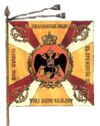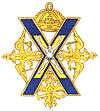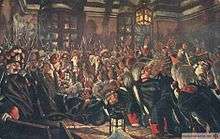Preobrazhensky Regiment
For the current Russian Army unit see: 154th Preobrazhensky Independent Commandant's Regiment
| Lifeguard Preobrazhensky Regiment Regiment — III — | |
|---|---|
|
Preobrazhensky regiment fighting the battle for Paris 30 March 1814, with the Montmartre in the background. | |
| Active | 1683-1917 |
| Country | Russian Empire |
| Branch | Army |
| Type | Infantry |
| Size | Regiment |
| Garrison/HQ | St. Petersburg |
| Insignia | |
| Banner of the regiment |
 |
| Badge of the regiment |
 |
The Lifeguard Preobrazhensky Regiment (Russian: Лейб-гва́рдии Преображе́нский полк , translit. Leyb-gvardi Preobrazhensky polk), was one of the oldest and guard / elite regiments of the Imperial Russian Army, and in 2013 was recreated for the Russian Armed Forces. Along with the Semyonovsky Regiment, the Preobrazhensky Regiment also served as a gendarmerie unit for the state Secret Chancellery (secret police) in the 18th century, headed by the Prince Fyodor Romodanovsky.
It was formed by Peter the Great in the late 17th century from his poteshnye voiska (потешные войска, "toy forces") during his military games in the village of Preobrazhenskoye (now a district in Moscow). The Preobrazhensky regiment distinguished itself during the Great Northern War of 1700–1721, the Patriotic War of 1812, and the Russo-Turkish War of 1877-1878. The regiment was disbanded by its last commander, Colonel Alexander Kutepov (later a general) in December 1917.
The body-guard of Catherine the Great, as well as the main supporter of her bloodless coup against her husband Peter III, this regiment was declared the highest in order of military precedence from 14 July 1762.
In the 18th and 19th centuries, membership was reserved to young Russian aristocrats and was considered a proof of loyalty to the government and the tsar. Among its membership was the Russian composer Modest Mussorgsky.[1]
Timeline
- 1683 - Peter the Great begins to assemble the droll regiments. Initially the number of soldiers was fewer than fifty.
- 1687 - Droll regiments become the Semenovsky regiment and Preobrazhensky regiments of the regular army.
- 1695 - Preobrazhensky regiment (nine companies) takes part in the Azov campaigns.
- 1696 - The regiment is divided into four battalions and two separate companies of bombardiers and grenadiers.
- 1700—1720 - Takes part in all major battles of the Great Northern War.
- 1700 - Before the Battle of Narva is officially named Leib-Guard Preobrazhensky regiment.
- 1706 - Tsar Peter the Great adopts the military rank of Colonel of Preobrazhensky regiment.
- 1722 - Takes part in the war against Persia.
- 1722 - According to Russian Table of Ranks soldiers of Preobrazhensky regiment were to be considered two ranks higher than in ordinary units.
- 1726 - Moscow company of Preobrazhensky regiment becomes a separate Moscow leib-guard battalion and later Murom leib-guard battalion.
- 1737—1739 - War against Ottoman Empire.
- 1737 - Takes part in the Battle of Ochakov.
- 1742 - War against Sweden.
- 1762 - On 17 July declared first and highest in the military order of precedence in the Imperial Russian Army and the Imperial Russian Guard.
- 1789—1790 - War against Sweden.
- 1796 - Battalions of the Preobrazhensky regiment are named according to their chiefs: 1st battalion - His Majesty, 2nd battalion - Lieutenant-General Tatischev, 3d Battalion - General Field-Marshal Suvorov, Grenadier Battalion - Major-General Arakcheev.
- 1805 - As a part of the Grand Duke's Corps of Guards the 1st and 3rd battalions leave St. Petersburg for Austria on 22 August; on 2 December take part in the battle of Austerlitz and return to St. Petersburg on 19 April 1806.
- 1807 - In February the Regiment, consisting of all 4 battalions, starts the march as a part of Grand Duke's Corps of Guards; on 5 June engages Ney’s troops near Guttstadt and Altkirchen and on 14 June takes part in the battle of Friedland; returns to St. Petersburg in August.
- 1808 - On 9 September the 2nd battalion of the regiment enters the Corps of Major-General Strogonov in Vilmanstrand (Finland).
- 1809 - On 10 March, being a part of the Corps of Lieutenant-General Prince Bagration, starts its march to Sweden through the Aland islands; on 14 March fights the enemy's rearguard on the island of Lemland; on 17 March stops on the Eckerö island, closest to the Swedish shore, and after the talks with Sweden begins moving back; returns to St. Petersburg in October.

- 1811 - The regiment is transformed into 3 battalions; each battalion now comprises one grenadier company (grenadier and tirailleur platoons) and three fusilier companies.
- 1812 - As a part of the Grand Duke's Corps of Guards, the regiment moves in March to Vilno, where it joins the 1st Western Army of Barclay-de-Tolly; on 7 September takes part in the battle of Borodino. During the French retreat from Moscow the regiment was in the reserve all the time and returns to Vilno in December.
- 1813 - On 13 January the Guard crosses the Nieman river in the presence of the Emperor; on 2 April participates in the grand parade in the presence of the Emperor and King Frederick William III of Prussia; on 14 April triumphantly enters Dresden; on 2 May takes part in the battle of Lutzen; on the 19th, 20th and 21 May the regiment is a central reserve under the command of Grand Duke in the battle of Bautzen; on 28 August and 29 August, being a part of 1st Guards Infantry Division under the command of General Yermolov, is distinguished in the Battle of Kulm.
- 1814 - On 13 January in the presence of the Emperor Alexander I the Regiment crosses the Rhine at Basel and as a part of the reserve of the Main Army under Barklay-de-Tolly, participates in every offensive and retreat until the battle of Paris (30 March); on 31 March triumphantly enters the capital of France; 1st battalion of the regiment has its bivouac near the Palace of Tuileries. After staying in Paris for more than two months the Regiment leaves for Normandy, embarking at Cherbourg on 15 June and on 12 August entering St. Petersburg through the Triumphal arch, constructed by the Emperor's order in the memory of excellent service of the Guard in 1812—1814.
- 1877—1878 - War against Ottoman Empire.
- 1906 - First Battalion excluded from the regiment and stripped of Leib-Guard privileges, instead the new first battalion of the regiment is formed from cavaliers of the Order of St. George and heroes of the Russo-Japanese War.
- 1914—1917 - World War I.
- 1917 - Participated in the February Revolution by their mutiny on Monday 12 March leading to the abdication of Tsar Nicholas II. Disbanded in December by Alexander Kutepov, its last commander.
- 2013 - Re-established as 154th Preobrazhensky Independent Commandant's Regiment
Flag
The regimental flag was of St. George's colours with the inscription: "For displayed feats in battle of Kulm 17th of August 1813". (29 August 1813 in the Julian calendar).
This colour was given to the regiment in order to celebrate its action at Kulm, where the outnumbered Preobrazhensky regiment withstood the charge of French troops.
March
The well-known "March of the Preobrazhensky Regiment" (Марш Преображенского полка) was written in the time of Peter the Great. It was also used as an unofficial national anthem in imperial times.[2] It is used often in Russia, also in the annual Victory Day parade for the trooping of the colours (Flag of Russia and Banner of Victory).[3] It is also the slow march of the Royal Marines.[4] Several people have written lyrics for the song.[5] It is not believed to have been officially used in the Soviet Union, but it had been played by Soviet military orchestras.[5]
Notable people who served in the Preobrazhensky Regiment
- Abram Petrovich Gannibal (1696-1781)
- Modest Mussorgsky (1839–1881)
See also
External links
| Wikimedia Commons has media related to Preobrazhensky Guard Regiment. |
- History of Preobrazhensky regiment - in Russian
- Preobrazhensky March - Regimental anthem
References
- ↑ BBC Radio 3. Composer of the Week, broadcast 26 October 2009
- ↑ "National Anthem | Russia's State Symbols". En.rian.ru. RIA Novosti. Retrieved 2013-11-30.
- ↑ https://www.youtube.com/watch?v=_d0wFG9WXq4 Archived May 23, 2014, at the Wayback Machine.
- ↑ "The Regimental Marches of Her Majesty's Royal Marines:A Life on the Ocean Wave Regimental Quick March". Royalmarinesbands.co.uk. Retrieved 2013-11-30.
- 1 2 "Russian Anthems museum". Hymn.ru. 2013-04-14. Retrieved 2013-11-30.
